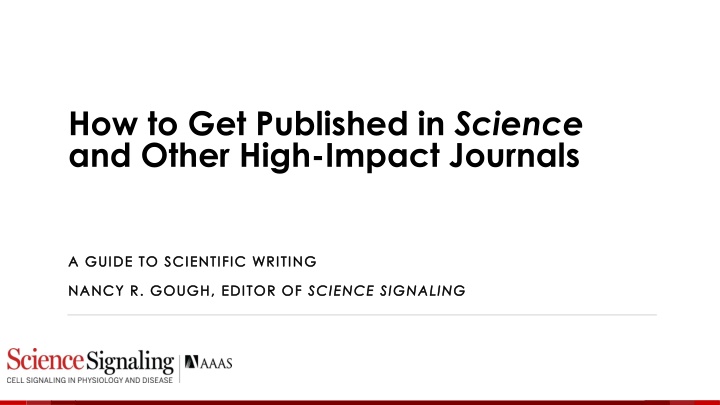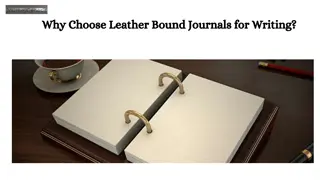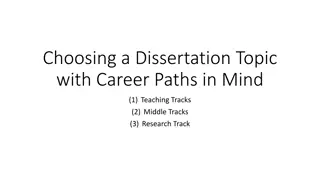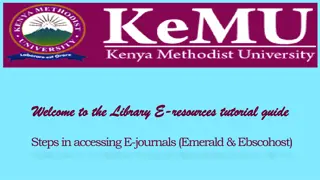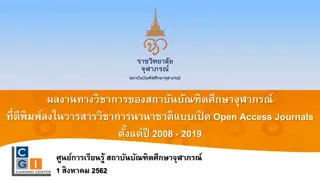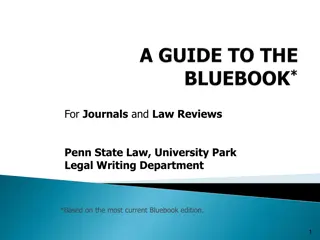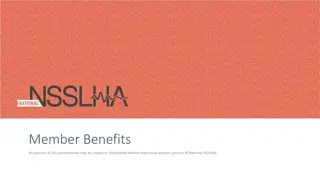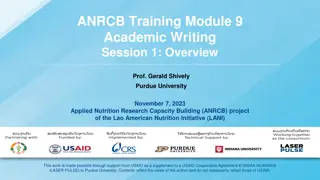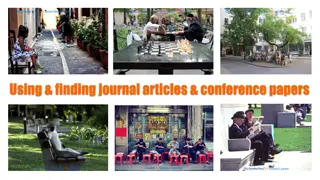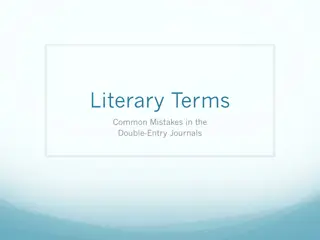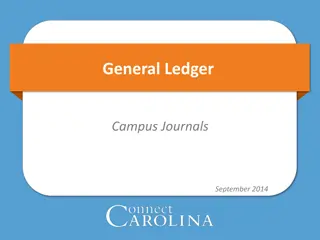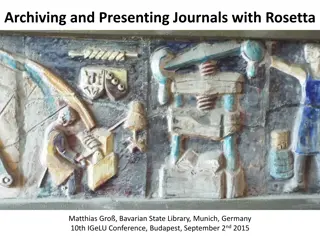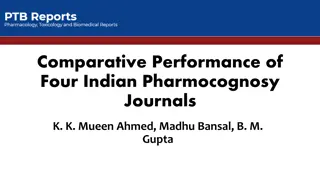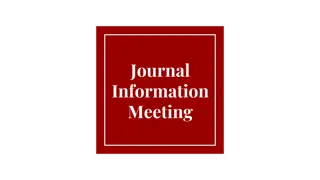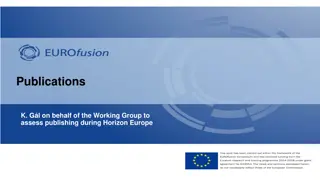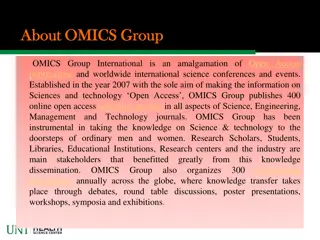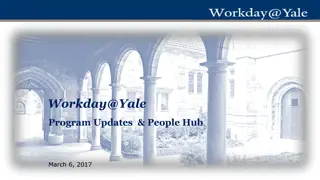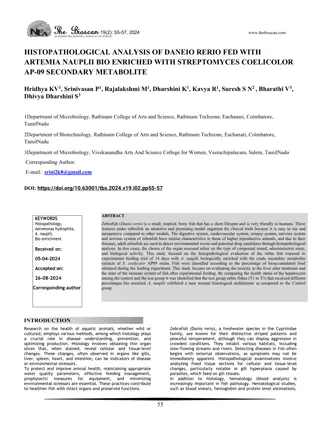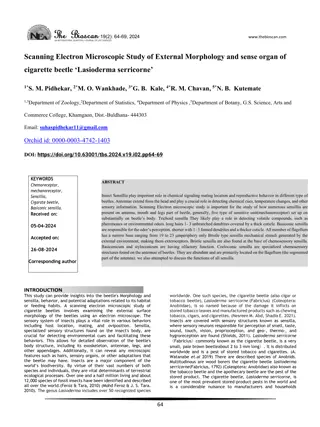Guide to Getting Published in High-Impact Science Journals
Valuable insights on scientific writing, publication opportunities in the AAAS Science Family of Journals, submission process details, review criteria, and acceptance rates, providing a comprehensive guide for aspiring researchers.
Download Presentation

Please find below an Image/Link to download the presentation.
The content on the website is provided AS IS for your information and personal use only. It may not be sold, licensed, or shared on other websites without obtaining consent from the author.If you encounter any issues during the download, it is possible that the publisher has removed the file from their server.
You are allowed to download the files provided on this website for personal or commercial use, subject to the condition that they are used lawfully. All files are the property of their respective owners.
The content on the website is provided AS IS for your information and personal use only. It may not be sold, licensed, or shared on other websites without obtaining consent from the author.
E N D
Presentation Transcript
How to Get Published in Science and Other High-Impact Journals A GUIDE TO SCIENTIFIC WRITING NANCY R. GOUGH, EDITOR OF SCIENCE SIGNALING
AAAS: Journal publisher and so much more Mission: Advance science for the benefit of all people Visit www.aaas.org for details ENHANCING GLOBAL POLICY & PUBLIC SUPPORTING EDUCATION OUTREACH ADVOCACY ENGAGEMENT CAREERS
The Science Family of Journals First issues in1880 Weekly in print and online Interdisciplinary scientific journal Subscription
The Science Family of Journals First issues in1999 (Science s STKE) Relaunch with new title 2008 Weekly online Specialty journal: cellular and organismal signaling in physiology and disease Subscription
The Science Family of Journals First issues in 2009 Weekly online Specialty journal: biomedical research from basic, translational, and clinical researchers Subscription
The Science Family of Journals First articles in 2015 Continuous online publication Interdisciplinary scientific journal Open access (author pays)
Where to submit? Journal scope and audience Review process and criteria Impact factor Article types and format Editorial board Sister journals Access
Submissions and Acceptance Rate 2014 Submissions Acceptance >11500 >700 >2600 n.d. 6% 19% 7% n.d.
Review process Professional editors Staff editors & Board of Reviewing Editors- review or reject? External in-depth review Reject, revise, accept Assist authors communicate research Academic editors Review or reject? Can serve as reviewers or send for external in-depth review Reject, revise, accept
Value of professional editors Have the power to overrule reviewers (and Board members) Highly skilled in finding appropriate reviewers Broad knowledge of the field and literature Not distracted by their real job Enhance accessibility of papers Invite commentary featuring research Help authors communicate scientific findings effectively
Gold versus Green Open Access Green Open Access Gold Open Access Authors pay full publication costs* Authors pay only a small part of the publication costs Articles are available immediately upon publication without fee to the reader Subscribers (institutional or individual) pay for immediate access Nonsubscribers can pay to access individual articles *generally not feasible for journals with professional editors, reviews and commentary, or news Science Advances Science Science Signaling Science Translational Medicine
Access to Science, Science Signaling, and Science Translational Medicine Immediate access: Research authors receive a toll-free link to their article immediately after publication. 6 months after publication: Accepted version of peer-reviewed content can be posted in authorized public repositories (PMC). 12 months after publication: Research content is freely available at the journal s website.
Submit to Science? Is your finding a big step forward with broad implications? Is your paper cross disciplinary? Did you apply a new technique to investigate difficult scientific questions? Is your research in the biological, physical, or social sciences? Is your study self-contained and suitable for the Science format?
Submit to Science Signaling? Do you study cellular or organismal regulation: with implications for understanding physiology and pathophysiology? with implications for understanding or treating disease? with mechanistic insight? with computational or modeling analysis leading to tested prediction? Was your paper recommended from Science or Science Translational Medicine?
Research Article or Research Resource? Is the study hypothesis-driven and are the hypotheses tested? Does the study provide a significant advance in understanding biological regulation? Research Article
Research Article or Research Resource? Is the study not testing a specific hypothesis? Does the study present a novel technique or tool with validation, without investigating a biological question? Research Resource Does the study provide a validated data set or describe applications of a validated database?
Submit to Science Translational Medicine? Does your research advance preclinical biomedical discoveries toward improved patient care? Does your research advance engineering discoveries toward improved patient care? Does your research take clinical observations back to the lab for mechanistic studies? Does your research inform health policy? Was your paper recommended by Science or Science Signaling?
Submit to Science Advances? Is your finding a step forward with a broad implication? Is your paper cross disciplinary? Is your research in the biological, physical, or social sciences? Does your funding agency require publication in an open access journal? Was your paper recommended from a Science journal?
Practical tips to getting published A GUIDE TO SCIENTIFIC WRITING
5 Golden Rules Know your audience Write clearly Write concisely Write accurately Follow instructions
When writing, think like They re intelligent. They want to understand. They don t know your experiments. The funder She has 20-30 active manuscripts. She handles multiple presubmission inquiries a day. She fields multiple inquiries from authors a day. She wants to find the best papers. The editor She gets lots of requests for money. She is not an expert in your field. She has 5 minutes before the next meeting. She wants to support research. Your family
Audience Scientists in your field Scientists outside of your field These people are drowning in information and very busy! Reviewers Editors Press and general public
Think like a reviewer Run your own review process A scientist in your own specialty A scientist in an unrelated specialty A good editor for the English language
Reviewing the manuscript The presentation The research Are errors and typos eliminated? Is the result important? Does the text read smoothly? Do the conclusions advance new concepts? Are needlessly convoluted sentences avoided? Is the approach original? Are the results described and not just a written statement of the data? Are the data reliable and reproducible (how many n)? Are the figures clear, well labeled, and selected to show the most critical information? Are the data properly quantified and statistically evaluated? Are experiments properly controlled? Does the discussion appropriately account for other research?
Think like a reviewer for a Science journal If correct, would this paper be interesting enough for a Science journal? If you saw this paper in Science, Science Signaling, Science Translational Medicine, or Science Advances would you say Cool! This changes my entire way of thinking! I can t wait to share this with my lab! What were those idiot editors thinking?
The cover letter This is your chance to speak directly to the editor. Explain the overall context of your results. What problem do they solve? Explain why you are excited about your work. (Don t forget to do these in the paper, also!) Keep it short, preferably 1 page. Have someone else proofread and edit it, especially if English is not your first language. If you are re-using your cover letter from submission of the paper to another journal, don t forget to change the name of the journal!!!
Think like an editor Are there good reasons to reject this paper? Are there good reasons to proceed with this paper? Is the paper within the journal s scope? Is the paper competitive? Can I convince my fellow editors of the value of this paper?
Think like an editor Can I grasp the main finding and importance from the abstract and cover letter? Is the title reflective of the main findings of the study? If I am having trouble grasping the message because of awkward writing or poorly presented figures, how will reviewers react?
Quick quiz: What were the 5 Golden Rules? Know your audience Write clearly Write concisely Write accurately Follow instructions
Write clearly Avoid imprecise words Regulates Alters Influence Precise Stimulates the activity Increases the abundance Represses the gene s expression Unambiguous Amount, abundance, or concentration Increase Substantial or important Genes, RNAs, and proteins Use italics for genes and transcripts Use plain text for proteins and active RNA molecules Avoid words with multiple meanings Levels Elevates Significant Avoid lab jargon
Write concisely Avoid convoluted sentences with multiple clauses Use simple declarative sentences; divide into two sentences if necessary If published work is not in dispute, present it as a fact Avoid presenting published results as a historical review
Write accurately Avoid claims of novelty Avoid speculation Avoid superlatives Correlations cause and effect Written spoken language Don t anthropomorphize Proteins are not people!
Writing samples: Before Abstract 109 words Pathogenic mutations in leucine-rich repeat kinase 2 (LRRK2) are the most common genetic cause of late onset Parkinson s disease (PD). There was mounting evidence that the intrinsic kinase activity of LRRK2 is required for LRRK2-mediated PD pathogenesis. However, recent studies suggested that LRRK2 kinase activity is dispensable for neuron survival and its protective activity against the neurotoxin. It was hypothesized that LRRK2 kinase domain might have a scaffolding role independent of its intrinsic kinase activity in the assembly of signaling complexes. In this regard, the intrinsic kinase activity of LRRK2 appears to be a Trojan horse for PD and modulation of its kinase activity could be potentially therapeutically beneficial.
Final Abstract 83 words Pathogenic mutations in leucine-rich repeat kinase 2 (LRRK2) are common genetic causes of late onset Parkinson s disease (PD). Initial studies indicated that the intrinsic kinase activity of LRRK2 is associated with LRRK2-mediated PD pathogenesis. However, the kinase activity of LRRK2 may be dispensable for neuron survival and may not be required for its protective activity against neurotoxicity. Thus, the intrinsic kinase activity of LRRK2 appears to be a Trojan horse for PD and inhibition of its kinase activity could be potentially therapeutically beneficial.
Research Article Abstract: Before (224 words) Cells derived from ataxia telangiectasia (A-T) patients exhibit defective cell cycle checkpoints following ionizing radiation (IR), profound radiosensitivity and high levels of chromosome aberrations. We have shown that transient ATM kinase inhibition from +15 to +75 min following IR is sufficient to radiosensitize cells and accumulate persistent chromosome aberrations. We show here that DNA-PK kinase inhibition from +15 to + 75 min is also sufficient to radiosensitize cells and accumulate persistent chromosome aberrations. The ATM kinase-dependent mechanisms that ensure cell survival and suppress chromosome aberrations during this interval are independent of DNA-PK kinase activity. Neither the activation nor the recovery of the IR-induced G2/M cell cycle checkpoint are affected by ATM kinase inhibition from +15 to +75 min, indicating that 15 min of ATM kinase signaling is sufficient to induce this cell cycle checkpoint. Surprisingly, ATM kinase inhibition from +15 to +75 min abrogates IR-induced sister chromatid exchange (SCE), a phenotype attributed to the repair of damaged replication forks. Further, ATM kinase inhibition using either KU55933 or KU60019 is sufficient to disrupt camptothecin-induced SCE. Since DNA damage-induced SCE is maintained A-T cells that express no ATM protein, and the ATM kinase inhibitors have no effect on DNA damage-induced SCE in A-T cells, these data reveal that the consequences of acute ATM kinase inhibition and adaptation to ATM protein disruption are distinct in S- phase cells.
Problems What is radiosensitivity? What is the relationship of radiosensitivity to chromosome aberrations? Cells derived from ataxia telangiectasia (A-T) patients exhibit defective cell cycle checkpoints following ionizing radiation (IR), profound radiosensitivity and high levels of chromosome aberrations. We have shown that transient ATM kinase inhibition from +15 to +75 min following IR is sufficient to radiosensitize cells and accumulate persistent chromosome aberrations. ATM kinase = The kinase that phosphorylates ATM? NO We show here that DNA-PK kinase inhibition from +15 to + 75 min is also sufficient to radiosensitize cells and accumulate persistent chromosome aberrations. What are ATM and DNA-PK? DNA-PK kinase = The kinase that phosphorylates DNA-PK? NO The ATM kinase-dependent mechanisms that ensure cell survival and suppress chromosome aberrations during this interval are independent of DNA-PK kinase activity. ATM kinase-dependent = Mechanisms that rely on phosphorylation of ATM? NO How does cell survival relate to radiosensitivity?
More problems Neither the activation nor the recovery of the IR- induced G2/M cell cycle checkpoint are affected by ATM kinase inhibition from +15 to +75 min, indicating that 15 min of ATM kinase signaling is sufficient to induce this cell cycle checkpoint. What is the IR-induced G2/M checkpoint? Why is this surprising? What do damaged replication forks have to do with IR-induced damage? Surprisingly, ATM kinase inhibition from +15 to +75 min abrogates IR-induced sister chromatid exchange (SCE), a phenotype attributed to the repair of damaged replication forks. Further, ATM kinase inhibition using either KU55933 or KU60019 is sufficient to disrupt camptothecin- induced SCE. Too much experimental detail. What is camptothecin?
And more problems Since should be because. Since DNA damage-induced SCE is maintained A-T cells that express no ATM protein, and the ATM kinase inhibitors have no effect on DNA damage- induced SCE in A-T cells, these data reveal that the consequences of acute ATM kinase inhibition and adaptation to ATM protein disruption are distinct in S-phase cells. Genes are expressed, not proteins. The information about S-phase is out of context.
Did your eyes glaze over? Lack of context Too much methodological detail Imprecise language Too many undefined terms
Clean edited version with editorial queries (182 words)
Practice Although most PD cases are sporadic, at least seven genes have been reported to be implicated in the pathogenesis of familial PD (1). (hint: too many words) In vitro studies indicated that several pathogenic mutations in LRRK2 caused an increase in the kinase activity, such as mutations R1441C in ROC GTPase domain and G2019S in kinase domain (4-6). (hint: multiple problems, including a misplaced clause) While the physiological function of LRRK2 remains largely unknown, recent studies indicated a dispensable role of the intrinsic kinase activity of LRRK2 in neuron survival and its protective activity against neurotoxin (10-12). (hint: multiple problems, especially temporal words) The current paper reports for the first time a sex reversal in transsexual people in the interstitial nucleus of the anterior hypothalamus (INAH) 3, a sexually dimorphic hypothalamic nucleus that was previously shown to be related to sexual orientation (citation 1, citation 2).
Practice while you read As you read for Journal Club, consider these best practices and pencil -edit the papers. As you read background materials for your research, find the errors and think about how the writing could be improved. Help each other. Read each other s manuscripts. Don t be afraid of the red pen!
